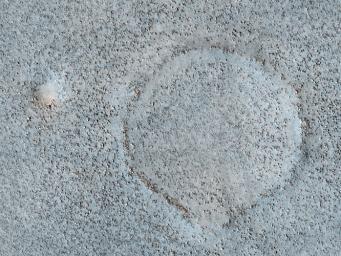Boulder Strewn Plain in Northern Utopia Planitia
Caption:
Common to the northern plains of Mars are rock and boulder strewn landscapes otherwise devoid of major features except a few impact craters. This image in the Cydnus Rupes region of northern Utopia Planitia is an excellent example of this sort of terrain. It was taken by the High Resolution Imaging Science Experiment (HiRISE) camera on NASA's Mars Reconnaissance Orbiter on Feb. 20, 2010.
Boulders up to several meters (yards) in size densely coat the landscape. The concentration of these boulders varies at several scales. In some areas only smaller rocks less than a meter across dominate the surface, while a couple hundred meters away may be a somewhat circular "blotch" of larger boulders. Often these blotches of boulders coincide with a faint circular ridge, such as seen here, the remnant of an impact crater now reduced by erosion and infilling to a a mere hint of a crater rim. Abundant boulders excavated by the impact, however, remain scattered over the surface to mark the past event.
Close examination of excavated large rocks and boulders may yield clues to the geologic processes that have shaped the regional landscape over Martian history. However, as a future landing site, these terrains are perilous. Large boulders can damage landing gear and puncture the underside of spacecraft. Rovers would find it extremely difficult to traverse through dense populations of large rocks and boulders.
This image covers a swath of ground about 1 kilometer (about two-thirds of a mile) wide. It is a portion of HiRISE observation ESP_016731_2360, which is centered at 55.5 degrees north latitude, 130.9 degrees east longitude. The season on Mars is northern-hemisphere spring. Other image products from this observation are available at
http://hirise.lpl.arizona.edu/ESP_016731_2360
.
Background Info:
The target for this HiRISE observation was a suggestion submitted through the camera team's HiWish public-suggestion program. For more information about how to submit target suggestions, see
http://uahirise.org/hiwish/
.
Color images from HiRISE combine information from detectors with three different color filters: red, infrared, and blue-green. Thus they include information from part of the spectrum human eyes cannot see and are not true color as the eye would see. The resulting false color helps to show differences among surface materials.
The University of Arizona, Tucson, operates the HiRISE camera, which was built by Ball Aerospace & Technologies Corp., Boulder, Colo. NASA's Jet Propulsion Laboratory, a division of the California Institute of Technology, Pasadena, manages the Mars Reconnaissance Orbiter for the NASA Science Mission Directorate, Washington. Lockheed Martin Space Systems, Denver, built the spacecraft.
Cataloging Keywords:
| Name |
Value |
Additional Values |
| Target |
Mars |
|
| System |
|
|
| Target Type |
Planet |
|
| Mission |
Mars Reconnaissance Orbiter (MRO) |
|
| Instrument Host |
Mars Reconnaissance Orbiter |
|
| Host Type |
Orbiter |
|
| Instrument |
High Resolution Imaging Science Experiment (HiRISE) |
|
| Detector |
|
|
| Extra Keywords |
Color, Crater, Impact, Infrared |
| Acquisition Date |
|
| Release Date |
2010-03-31 |
| Date in Caption |
2010-02-20 |
|
| Image Credit |
NASA/JPL-Caltech/University of Arizona |
| Source |
photojournal.jpl.nasa.gov/catalog/PIA12990 |
| Identifier |
PIA12990 |

 Planetary Data System
Planetary Data System
